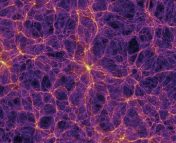Title: Probing the missing baryons with the Sunyaev-Zel’dovich effect from filaments
Authors: Anna de Graaff, Yan-Chuan Cai, Catherine Heyman, and John A. Peacock
First Author’s Institution: Institute for Astronomy, University of Edinburgh, Royal Observatory, Blackford Hill, Edinburgh, UK; Leiden Observatory, Leiden University, Leiden, The Netherlands
Status: Published in Astronomy & Astrophysics, open access on arXiv
The Missing Baryon Problem
All of the material we see around us is made up of atoms, also known as baryonic matter. From studies of Big Bang Nucleosynthesis and the Cosmic Microwave Background (CMB), we know that baryons make up only 5% of the Universe. The rest is made of still largely unknown forms of matter and energy we call dark matter and dark energy. We have a problem though with the 5% of the Universe we know about: we don’t know where all the baryons are.
Baryons in galaxies and galaxy clusters make up only ~20% of all baryons in the Universe. The existence of another ~30% of the baryons can be inferred from the Lyman-alpha forest. Cosmological simulations suggest that the rest of the baryons (roughly 50%) reside in the WHIM (warm-hot intergalactic medium). The WHIM is composed of filaments and sheets of warm-hot gas that connect galaxies and galaxy clusters. Because emission from this gas is faint, finding baryons in the WHIM is difficult. Previous work has relied on studies of absorption lines of distant quasars and X-ray absorption. Using these methods, we have found just 20% of the total baryon budget in the WHIM, far less than the theoretically expected 50%. Thus, summing up all the known baryons gives us only 70% of all the baryons in the Universe.
Finding the WHIM
An alternative technique to measure baryons in the WHIM is known as the thermal Sunyaev- Zeldovich (tSZ) effect. The tSZ effect measures the change in energy of photons from the CMB caused by interactions (inverse Compton scattering) with hot particles along our line of sight. In order to apply this method, this paper utilizes maps of galaxies from the Sloan Digital Sky Survey to create both a sample of galaxy pairs that are likely to be connected by a filament and a control sample of pairs of galaxies that are physically unrelated, but closely separated on the sky. The authors also use the Planck map of the Compton y-parameter, which quantifies the strength of the tSZ effect.
Because the tSZ signal from the WHIM is weak, the authors add together the signals of over a million pairs of galaxies, rotating and scaling each particular pair as needed. In order to measure the tSZ signal from the filament, rather than the galaxies themselves, a model is used to subtract the contribution of hot gas in the galaxy halos. Figure 1 shows the summed signal, the galaxy halo models, and the residual signal from the filament.

Figure 1: (a) Sum of tSZ signal for ~1 million galaxy pairs; (b) modeled galaxy halo signal; (c) residual between the data and model. The filament is marked by the dashed box in (c). The axes represent distances parallel (
The authors recognize that this signal may not be from the WHIM, but rather from unrelated sources, leftover galaxy halo signal, or the cosmic infrared background. To confirm that these signals are in fact caused by particles in the WHIM, the authors ran the same tests on their control sample, created a simulated tSZ signal map for the halos, and estimated dust contamination. They found that the only potential contamination is from galaxy halos, contributing less than 20% of the observed filament signal.
Baryons: Present and Accounted-For?
Confident that the signals from the filaments were real, the authors needed to estimate how many baryons they had found. Using constraints on the gas temperature and density from gravitational lensing and previous studies, they claim to have found an additional 11 ± 7 % of all baryons. Figure 2 summarizes our current knowledge of the distribution of baryons in the Universe. When interpreting the final results, it is important to note that this paper’s galaxy pair sample is incomplete and that deeper surveys may be able to find even smaller filaments that this work missed.

Figure 2: Left panel – known distribution of baryons as of 2012 (Shull et al. 2012). Right panel – census of baryons after this work, with the newly discovered baryons shown in red (Figure 8 in the paper).
If we now add up all the known baryons, we are still missing 18 ± 16 %. Further studies of quasar absorption lines, X-ray absorption, and the thermal SZ effect to include more galaxies may help to find more baryons in the WHIM, especially at different temperatures. While it is clear that there is still work to be done and more baryons to find, at least now we can be confident we are looking in the right place.




Hi, I found a mistake here. The interaction in the tSZ effect is actually inverse Compton scattering instead of Compton scattering.
You’re right, thanks for catching that. I’ll update the post to fix this!